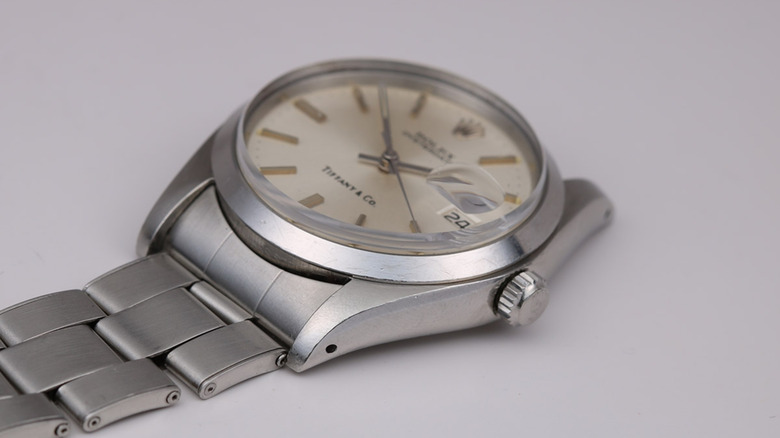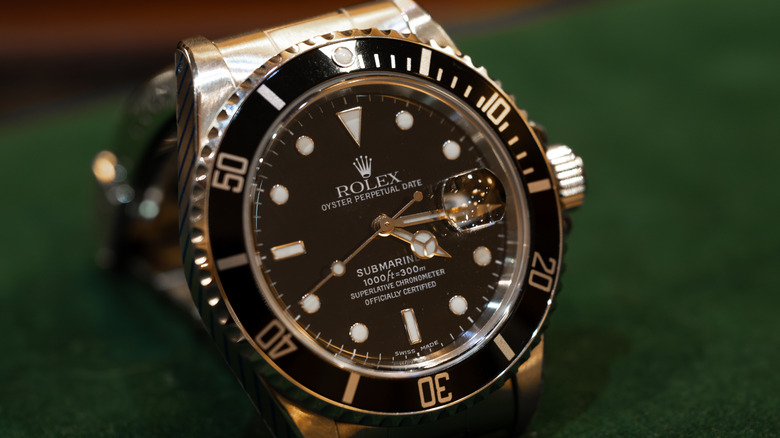One Of The Cheapest Rolex Watches Is A Discontinued Model For $4,000 Or Less
Rolex built the Oysterdate 6694 in stainless steel from the early 1960s until it was discontinued in 1989. It was sold as a "Precision" model and holds a place in history as the last manual-wind watch the brand ever offered. Its design is clean and simple, featuring a slim 34 millimeter Oyster case, an acrylic crystal, a screw-down crown, and a date window at 3 o'clock beneath the signature cyclops lens. There's no gold like you'll find on the Rolex Day-Date, and no automatic movement like the Double Red Sea-Dweller or the Rolex Submariner, instead, you'll find only the core features that helped make Rolex a household name.
WatchCharts shows that the Oysterdate 6694 had 2,120 sales in the past year. That puts it in the top 5% of all Rolex models by trading volume, making it one of the most actively bought and sold vintage pieces on the market. But more than volume, price is where this model stands out. Chrono24's November 2021 list of "The 5 Most Affordable Rolex Watches" showed the Oysterdate 6694 selling between $2,500 and $4,000. In 2025, Bob's Watches listings go up to $4,995, which is about 25% to 100% increase in just four years. Still, you can own one starting at $2,000 before you move up to $5,000 depending on the dial, year, and condition.
Key features of the Oysterdate 6694
First released in the early 1960s, the Oysterdate 6694 was priced at $130 in Rolex's 1968 U.S. catalog. It stayed affordable by skipping the automatic winding rotor and official accuracy testing. The Oysterdate 6694 features a strong and simple design and its 34 mm stainless-steel case sits flat on the wrist and fits easily under a shirt cuff. Most came with an Oyster bracelet, but many dealers also offer the case alone, ready to pair with a leather strap. The Oysterdate 6694 runs on Rolex's hand-wound caliber 1225, and its 17-jewel movement ticks at 21,600 beats per hour. It also has a power reserve of about 40 hours when fully wound.
Since Rolex didn't send it for official Swiss accuracy testing, the dial reads "Precision" instead of "Superlative Chronometer Officially Certified." The screw-down crown and sealed Oyster case were originally rated for 100 meters of water resistance, so it can handle everyday splashes without concern. Dial colors include silver, black, blue, and others, giving buyers style options without the higher price of gold models or rare features. Its simple, easy-to-service movement and compact size, suitable for most wrists, make the 6694 a top choice for anyone seeking a vintage Rolex under $5,000.
Why it was discontinued and what followed
Rolex stopped making the Oysterdate 6694 in 1989 as the brand shifted toward automatic watches with certified accuracy. By then, Rolex had already released the quickset caliber 3035 in 1977 and the improved caliber 3135 in 1988. These newer models, offering easier date setting and more precise timekeeping, positioned the 6694 as the last manual-wind Rolex.
By the late 1980s, Rolex had fully shifted to automatic watches. The quick-set caliber 3035 had powered the date line since 1977, and the upgraded caliber 3135 arrived in 1988. That same year, the Daytona switched to the Zenith-based automatic caliber 4030. With every other Oyster-cased model now labeled "Perpetual," the hand-wound, non-certified Oysterdate 6694 was the last of its kind.
The Oyster Perpetual Date, particularly reference 15010, effectively succeeded the 6694 despite its 1983 introduction. It kept the same 34 millimeter case style but came with the automatic caliber 3035 and full chronometer certification. Chrono24 lists the 15010 starting around $4,200 and reaching up to $5,000, which is almost $1,000 more than some clean 6694 models. That price gap, along with the automatic movement and slightly larger feel, are among the reasons the 6694 was discontinued.


